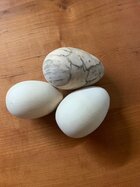Yesterday I was turning an egg out of some spalted maple. The set up had the blank mounted in a chuck in spindle orientation, no tailstock, and the egg aligned such that the blunt end was towards the tailstock and the pointed end towards the headstock.
I found myself struggling to produce a reasonably fair curve on the blunter end of the egg. I am a natural lefty, and to shape the blunt end had the skew on my left side and therefore my body was in front of the bevel. After turning it, I was starting to think about my process and wonder if it would be a better idea to swap hands, such that the skew handle is on my right hip. This would place my body behind the bevel, and allow freer movement in theory. Putting aside for a minute that righty is not natural for me, and my mechanics are therefore a bit rougher. The movement has to go from parallel to the axis of rotation to perpendicular to the axis - my thought is my body might be getting in my way.
Turning the pointed end of the egg kept the skew on my left hip, body behind the bevel, and had no problem.
Any thoughts? This strikes me as sort of being akin to 'running around your backhand' in tennis.
I found myself struggling to produce a reasonably fair curve on the blunter end of the egg. I am a natural lefty, and to shape the blunt end had the skew on my left side and therefore my body was in front of the bevel. After turning it, I was starting to think about my process and wonder if it would be a better idea to swap hands, such that the skew handle is on my right hip. This would place my body behind the bevel, and allow freer movement in theory. Putting aside for a minute that righty is not natural for me, and my mechanics are therefore a bit rougher. The movement has to go from parallel to the axis of rotation to perpendicular to the axis - my thought is my body might be getting in my way.
Turning the pointed end of the egg kept the skew on my left hip, body behind the bevel, and had no problem.
Any thoughts? This strikes me as sort of being akin to 'running around your backhand' in tennis.

